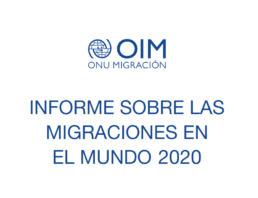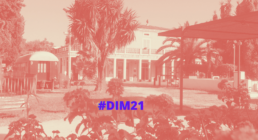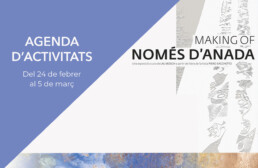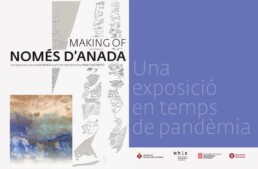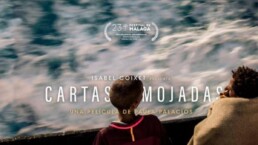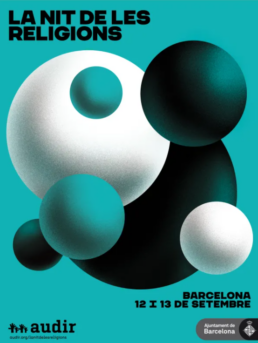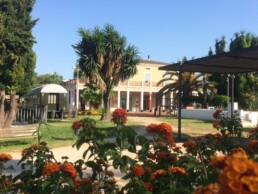World Migration Report 2020
MhiC Recommends
World Migration Report 2020
The International Organization for Migration has published its annual report on global migration for 2020.
On its website you will find the report in PDF format and a summary with interactive visualizations to explore the data, including a migration corridor with world data(2020).
Link: https://worldmigrationreport.iom.int/wmr-2020-interactive//?lang=EN
Since 2000, IOM has been producing world migration reports. The World Migration Report 2020, the tenth in the world migration report series, has been produced to contribute to increased understanding of migration throughout the world. This new edition presents key data and information on migration as well as thematic chapters on highly topical migration issues.
Share on facebook
Share on twitter
Share on email
Share on telegram
Share on whatsapp
Podcast and Audio guide
The Long Night of Museums is here!
Let's take a night trip to the museum with the podcast of the 2021 Long Night of Museums and discover the Visitmuseum audio guide.
ONLINE: at 20.00h MhiC closes its doors to the public and opens its virtual windows with the PODCAST. Night trip to MhiC.
The podcast is currently only available in Catalan.
Several voices will bring us closer to the museum and its territory, the municipality of Sant Adrià del Besòs. MhiC, its theme, the people that surround it and the new tools to get to know the museum, on-site and from the distance…
Why is MhiC a 21st century museum and how does it materialize its educational vocation? What does it mean to have an open background and built on the contributions of the audience and how does that turn people into narrative actors? How does the museum relate to its surroundings, guided tours and educational programs?
Participants:
Filo Cañete Carrillo, Mayor of de Sant Adrià de Besòs
Josep Manuel Rueda Torres, Director of Agència Catalana del Patrimoni Cultural
Imma Boj, Director MhiC
Jordi Vilalta, Educator MhiC
Carles Jódar, Speaker
Norman López, Technician
Gedi Media, Production
You can play the podcast here, at Soundcloud and iVoox. [ Catalan ]
ONLINE: The Visitmuseum AUDIO GUIDE is now available.
Discover MhiC through Visitmuseum.
Visitmuseum is an initiative promoted by the Catalan Cultural Heritage Agency. The audio guide is an element that supports the on-site visit to the museum allowing visitors to complement their journey with content available in several languages, and a tool for virtual tours through the free mobile application (Android and iOS) and through the web version.
MhiC's audio-guide is available in four languages: Catalan, Spanish, English and French.
For each museum facility, Visitmuseum offers a brief presentation, a tour of the main thematic areas and a detailed look at the most outstanding objects. The application also presents all the practical data for the visit and the corresponding links for sharing the experience on social networks.
Share on twitter
Share on facebook
Share on telegram
Share on whatsapp
Share on email
Agenda of activities. Making of One Way Ticket (Solo andata)

Actualidad MhiC
AGENDA OF ACTIVITIES. MAKING OF ONE WAY TICKET (SOLO ANDATA)
From 24th February to 5th March , a series of activities will be held on the occasion of the exhibition Making of One Way Ticket (Solo andata) where we will present all the educational projects of this year.
For security reasons, attendance at the presentations is limited to project participants and museum staff, but remember that you can visit the exhibitions in small groups of up to ten people.
#CulturaSegura.
24/02
10h
Inside the suitcase: Migration, art and experience
Presentation of the exhibition project by the students of 3rds of ESO ‘B’ from IES Barres i Ones.

25/02
10h
Inside the suitcase: Migration, art and experience
Presentation of the exhibition project by the students of 3rds of ESO ‘A’ from IES Barres i Ones.
17h
One Way Ticket. Luggage
Presentation of the documentary produced by the MhiC and directed by Maria Chatzi based on the corporal expression workshop coordinated by Elena Ananiadou and carried out by the choreographers Pere Faura and Jumon Erra with the group of recently arrived boys from GEDI.
17:45h
One Way Ticket. Luggage
Discussion forum about the documentary with the participants of the project.
18h
Blog – Making of One Way Ticket (Solo andata)
Presentation of the exhibition web project curated and created by Lilianna Marín de Mas.

01/03
10h
Inside the suitcase: Migration, art and experience
Presentation of the exhibition project by the students of 3rds of ESO ‘C’ from IES Barres i Ones.
03/03
10h
Inside the suitcase: Migration, art and experience
Presentation of the exhibition project by the students of 3rds of ESO ‘E’ from IES Barres i Ones.
05/03
10h
Inside the suitcase: Migration, art and experience
Presentation of the exhibition project by the students of 3rds of ESO ‘D’ from IES Barres i Ones.

Production: MhiC- Ayuntamiento de Sant Adrià del Besòs .
Colaboration: Students 3rds of ESO from IES Barres i Ones / Boys from GEDI. Vilafranca del Penedès.
Virtual exhibition. Making of One Way Ticket (Solo andata)
And on the faces
the squalls emerge, quiet currents
and the leaping of fish that dream of flying
In the first days of 2020, we were very excited to receive the boxes with the paintings that would be the main stars of the exhibition Solo Andata (One Way Ticket), by the Italian artist Piero Sacchetto and curated by Lali Bosch. At the same time, a dialogue was established with a series of educational projects created by the boys and girls of 3rd year of ESO from IES Barres i Ones in Badalona and by the group of boys from the CRAE Kirikú and the association A Bao A Qu.
Two months later, the world was confined, but we were looking for ways to keep in touch, generating interactive content and rethinking the/a way to visit the exhibition.
As a result of this long-distance exchange, the exhibition that you can currently visit at the MhiC was born: Making of Solo Andata. An exhibition in times of pandemic. There, we focus on that moment in 2020 when the days stopped because of the confinement, which prevented many people from visiting the museum, but also, where we show the next step of all the projects we exhibited at that time, as well as their evolution and continuity throughout 2021.
Although the exhibition is open to the public according to all security measures, we also want to offer you the possibility of accessing (to its materials) through this blog created ad hoc to the times we are living in.
Scroll down the tabs you will find below and discover the journey of this project. Like a travel log, each one of them will show you the materials displayed in the current exhibition and also others that are unpublished. Read, download, watch and visit the links to enjoy an exhibition in continuous movement.
We pack our bags: The discovery that leads the journey
Reading and travelling are two actions that have always been closely linked, and in times of confinement this statement has become more evident than ever.
Piero’s journey to the MhiC also begins with a reading of poems’ collection of Solo Andata (One Way Ticket) by the Italian writer Erri de Luca. By chance, the book meets the painter, who translates on the canvas words that have a familiar tone for him.
I feel that it speaks of people who, like me, have desires, dream, enjoy, have dreams, cry, tremble, who can be accepted or excluded from their own environment.
Thus, begins a back and forth between words and painting. The words are transformed into colours which, as the work progresses, intersect, multiply and acquire different textures. As a result, Piero Sacchetto’s studio is filled, on those days in 2017, with shapeless paintings that speak to us of connections, aromas, memories, landscapes and transitions, the seed of Erri de Luca’s poems.
I let the colours begin to manifest themselves. The colours of damp or sunburnt earth, the red of oxides, of the light that takes different forms from protection to oblivion, of the white that can never be hidden, of the black tar that coats wood and transforms it into a boat...
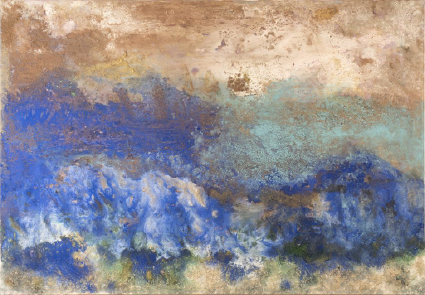
This is how Erri de Luca’s voice mimics in the work of Piero Sacchetto, who sees his works as asking him to begin a journey like the one he has made with the reading of Solo Andata.
Solo Andata, the poet's book is becoming hidden behind my paintings and I am beginning to think that my paintings are also beginning their journey outside the studio.
Today they have crossed borders as only paintings can: in silence.
And it is in silence that they hope, like myself, that the gazes of the people who have to look at them will awaken in them as many questions as the reading of Erri de Luca's poems awakened in me one day.
Who is who?
Erri de Luca (Naples, 1950)
Writer, journalist, and poet. Before becoming a writer, he had many kinds of jobs: lorry driver, mason, factory worker... He has also self-taught many languages. His first book, Not Now, Not Here (1989), tells the story of his childhood in Naples and has been translated into more than thirty languages. Since then, he has not stopped writing (essays, poetry, theatre...).
He is also a mountaineering enthusiast and contributes to national newspapers such as Corriere della Sera.
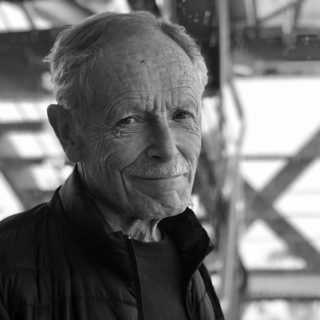
Piero Sacchetto (Pieve di Cento -Bologna-, 1950)
Painter and humanist. He has based his life on research and the creation of projects related to the field of primary education and pedagogy, focusing these disciplines on the world of the arts and museums. His experience has made him a reference in this field, which has been recognized in different projects and articles in specialized journals.
He has also been responsible for directing the creation of various artistic spaces in Bologna and for the realization of theatrical scenographies.
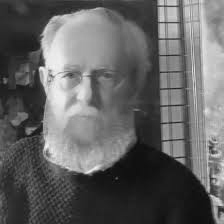
First Stop: One Way Ticket (Solo andata), MhiC 2020
The exhibition Solo Andata (One Way Ticket) works aesthetically and ethically on the motifs linked to migratory movements that force people to leave towns, cities, and countries. For this reason, the exhibition, despite the strangeness of the times in which we live, is also at a migratory point since conceived as an itinerant exhibition, we can currently visit it at the Museu de la Vida Rural – Fundació Carulla in Espluga de Francolí.
THE EXHIBITION BEGINS TO TAKE SHAPE
The months leading up to the opening were a constant stream of e-mails in which we mixed different reflections and negotiations. The works were traveling from Pieve di Cento (Bologna) to Sant Adrià del Besós (Barcelona), a delicate route that we had to prepare with great care. But, before all that happened, the curator and the museum team worked on the exhibition room where the works would be displayed and, at the same time, we all coordinated together with the educational activities that would be linked to the exhibition… Finally, at the beginning of January 2020, the paintings arrived and so did Piero.
Photos of the production of “Només d’anada” at the MhiC (gener, 2020).
We start the exhibition set-up, and the museum is surrounded by special music: laughter and conversations. The instruments create that, the meeting of the artist with the boys and girls from IES Barres I Ones and the boys from CRAE Kirikú, who are also working in the rooms with their respective projects. Altogether we were weaving a choral exhibition.
One of the e-mails between Lali Bosch and Piero Sacchetto shows us, once the confinement is over, the memories that those first days bring back to them when the exhibition was just an idea.
To: Piero Sacchetto
R: Do you remember?
September 16, 2020
Dear Piero,
The day after tomorrow we will be opening NOMÉS D'ANADA, your SOLO ANDATA, in the Rural Life Museum in L'Espluga de Francolí. By the way, very close to Mont-roig del Camp where Joan Miró spent part of his childhood. Remember that day in your workshop in Pieve di Cento where together we dreamed of the possibility of traveling with your canvases to Barcelona? It was the beginning of the summer of 2017 and everything seemed to us possible, although a bit complicated as well. Do you remember that moment?
From: Piero Sacchetto
To: Eulàlia Bosch
R: Do you remember?
September 17, 2020
Yes Lali, I remember well: the paintings arranged on the table in front of us, waiting for your comments. That's when we started dreaming that the canvases could come out of the studio one day. Then, we didn't know how, when and where they could travel. Why not Barcelona, I remember you said. Dreams are made of time and enclose many surprises although sometimes they just fade away.
First the canvases made small steps in Italy outside the studio: they travelled to an art circle, an art gallery and also the regional museum of Piedmontese emigration.
Encounters with glances more or less intense and prolonged by curiosity and interest. Suddenly, our dream takes on a new life that has a name and a concrete address: the paintings find shelter in the Museum of the History of Immigration of Catalonia in Barcelona.
Previous
Next
E-mails between Lali Bosch and Piero Sachetto before the opening of “Només d’anada” (MhiC, 2020).
The curator and the artist each working from their ateliers.
A PARTY FOR EVERYONE
Finally, on 25 January 2020, we opened Sólo de ida. More than two hundred people came to the MhiC to celebrate it: staff, artists, students, family and friends… There was a festive atmosphere in the rooms and in the garden. Little could we have imagined that this would be one of the last times we would interact normally.
On 15 March, the museum had to close its doors, a global pandemic forced us to do so and we had to act responsibly. Piero’s works and educational projects were put on stand by.
Exhibition opening day of “One Way Ticket” on 25 January 2020. The inauguration was attended by all the participants and the musical performance of Guillem Roma and Alessio Arena..
One Way Ticket (Solo andata) educational projects
At the same time, the MhiC hosted, within the context of the exhibition, four educational projects, developed by the students of the 3rd year of ESO from IES Barres i Ones and the young people from CRAE Kirikú, with the collaboration of the association A Bao A Qu.
GOING UPSTAIRS, WORD BY WORD
Step by step, we reach the exhibition hall. A metaphor of the journey accompanied in this case by words. These words are a dialogue between the work of Piero Sacchetto and the poetry of Erri de Luca, which the students of the 3rd year of ESO from IES Barres i Ones have unravelled from the poems and paintings of both authors. From a distance, the words unite us as we move along the path.
The boys and girls of IES Barres i Ones at the installation of “Going upstairs, word by word”.
Participants:
Ahad Abdul, Evan Älvarez, Yanina Araujo, Gift Baidoo, Serek Casado, Ayman Dghoughi, Aryan Dogra, Salman Douas, Jorge Ferrel, Laura García, Yanira González, Paula Gonzálvez, Ali Haider, Victoria Heredia, Anthony Herrera, Zora Latif, Xiao Liu, David Marchal, Mayori Martínez, Lídia Melero, Antonio Morales, Arnaldo Pacheco, Ana Pérez, Eber Ramos, Faraj Sahboun, Jordi Urbina, Rukhma Wlalayat and Hao Zheng.
Accompanied by teachers Diana Ros and Damiana Moreno.
.
SEA
ROADS
The pupils of IES Barres i Ones, opened a dialogue with Piero – first by email and then live during the exhibition set-up – from which the audiovisual Camins de mar emerged. The displacements, the emotions, the sea, the sky and the earth will be the first elements shared between the students and the artist.
In the following link you can see it: https://vimeo.com/386954396
Participants:
Maikol Yordan Aguilar, Olga Aguilera, Lluís Ángel Álvares, Gabriel Amaya, Mounir Bouaouda, Franchesca Curiel, Bilal El Baouti, Ingrid Ferrer, Lucía Galera, Sandra García, Natalia López, Muhammad Asad, David Martínez, Gabriel Norte, Víctor Patón, Óscar Regalado, Jesús Robles, Erika Román and Alexis Solórzano.
Accompanied by the teachers Irene Lop, Damiana Moreno, José Ángel Prieto and the filmmaker Maider Fernández Iriarte.
CARTOGRAPHIES OF EMOTION
Cartographies of emotion, also produced by the 3rd year ESO students of IES Barres i Ones, establishes very real stories on a map of an indeterminate place. The students collected testimonies of people close to the them and created a map with an emotional cartography that links with coloured threads different emotions of what migration entails.
The boys and girls of IES Barres i Ones at the installation of “Going upstairs, word by word”. “Cartographies of emotion”.
In the following legend you will find the relationship between each colour and its emotion:
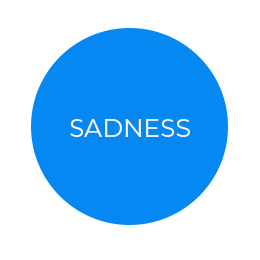



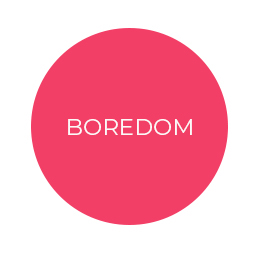
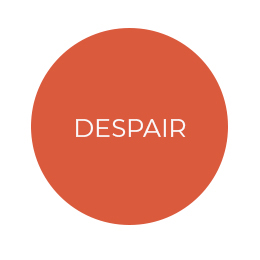



Click on the different boxes and find out what story and emotion is behind each one.

YOLANDA VICTORIA CHÁVEZ TUESTA
Year of birth: 1965
Years lived in the country of origin: 26
“...Anant a un altre país no saps el que t’espera, però, s’ha de fer”

Any d'arribada: 1991
Motiu migratori: econòmics i per seguretat
“En aquell moment, no penses com serà l’arribada, solament t’entra la nostàlgia”

Antonia
Any de naixement: 1945
Anys viscuts a la seva terra d’origen: 7
“el meu pare es va quedar sense feina. era la posguerra y no hi havia feina però sí molta necessitat”

Any d'arribada: 1952
Motiu migratori: econòmic
“Arribats a Barcelona, sense casa ni feina i nens petits, la meva mare sí que va tenir dificultats”

Elena Cabeza
Any de naixement: 1969
Anys viscuts a la seva terra d’origen: 28
“els costums no són massa diferents, però sí que segueixo fent algunes receptes”

Any d'arribada: 1991
Motiu migratori: per amor i per feina
“la meva infància va ser feliç. anava a una escola petita i jugavem al camp”

Hafida Laamim
Any de naixement: 1974
Anys viscuts a la seva terra d’origen: 26
“Només vull que les meves filles tinguin una bona educació”

Any d'arribada: 2000
Motiu migratori: per millorar la vida
“recordo el mar i les amigues, com passejavem per la sorra i el mar s'enduia les nostres sandàlies”

Ibrahim Zarrougui
Any de naixement: 1979
Anys viscuts a la seva terra d’origen: 24
“Volia una vida millor i viure bé, més endavant amb un bon futur”

Any d'arribada: 2003
Motiu migratori: voluntari
“Em vaig sentir avorrit, molt perdut i sol la primera vegada en tocar aquesta terra”

MARIA DOLORES MARZO
Any de naixement: 1990
Anys viscuts a la seva terra d’origen: 27
“...vaig trobar a gent molt amable i no em va costar acostumar-me”

Any d'arribada: 2017
Motiu migratori: per feina
“La diferència és que allà vivia amb la meva família, i aquí no”

Eliane Rodrigues Kramer
Any de naixement: 1979
Anys viscuts a la seva terra d’origen: 32
“És sortir, donar la cara i no tenir mandra”

Any d'arribada: 2011
Motiu migratori: millorar la situació dels seus fills
“Tot i que Barcelona és la meva llar, Brasil sempre serà la meva terra"

Maryan Taidi
Any de naixement: 1983
Anys viscuts a la seva terra d’origen: 18
“Soc una persona molt oberta, simpática i no em va costar gens adaptar-me”

Any d'arribada: 2002
Motiu migratori: millorar en general
“Tots tenim dret a canviar, tenir un futur millor”

Carlos Ponce
Any de naixement: 1978
Anys viscuts a la seva terra d’origen: 21
“És molt trist saber que quan arribaràs estaràs sol, però a la vegada et fa més fort”

Any d'arribada: 2011
Motiu migratori: per amor i per cercar noves oportunitats
“L'alegria de que et deixin passar. un immigrant sempre està pensant en això"

Manuela Díaz Sieiro
Any de naixement: 1943
Anys viscuts a la seva terra d’origen: 14
“”...soc de Galicia, provincia d'Ourense”

Any d'arribada: 1960
Motiu migratori: millorar la vida
“...m'agrada molt la gent de Catalunya”

Montse López
Any de naixement: 1982
Anys viscuts a la seva terra d’origen: 7
“molta alegria al recordar la infància i tot el recorregur que he fet fins aquí”

Any d'arribada: 1989
Motiu migratori: la família volia millorar
“...no és fàcil, però estic fent molt d'esforç per aprendre la llengua"

Carlos Contrera
Any de naixement: 1979
Anys viscuts a la seva terra d’origen: 11
“”Hi ha molts sentiments retrobats, un vol estar al seu país d'origen, però ara no es pot”

Any d'arribada: 2007
Motiu migratori: per seguretat
“ara agraeixo estar aquí, que és on he format la meva família”

Eduardo Gallego Mora
Any de naixement: 1976
Anys viscuts a la seva terra d’origen: 38
“Tot el que m’ha passat ha sigut allí”

Any d'arribada: 2014
Motiu migratori: per feina
“Vaig venir pel meu propi compte i va ser una aventura"

Isaac Bascope
Any de naixement: 1982
Anys viscuts a la seva terra d’origen: 20
“és una de les joguines de quan era petit. estaven de moda i hi havia de molts tipus"

Any d'arribada: 2007
Motiu migratori: fugir de la pobresa
“al principi va ser molt dolorós i em vaig haver d'esforçar molt, però ha merescut la pena”
Participants:
Els i les alumnes de 3r d’ESO de la promoció 2019-2020 de l’IES Barres i Ones de Badalona acompanyats pels docents del centre.
FROM AFRICA, WE DISCOVER BARCELONA
Within the project “Photography in progress” of the association A Bao A Qu and with the support of the photographer Mònica Rosselló, the group of young migrants of the CRAE Kirikú carried out the exhibition From Africa, we discover Barcelona, which, like the rest of the activities, was part of Solo Andata.
Click HERE to see the making of the project, as well as a video of the opening day of the exhibition.
The boys of Kirikú-EduVic at the installation “From Africa, we discover Barcelona”.
With their gaze, recently arrived in the city, and photography as a graphic testimony, these young people help us discover Barcelona from different perspectives (Bogatell beach, Montjuïc from the formal purity of the Miró Foundation, the Carmel batteries…). Images that link up again with the work of Piero Sacchetto: sea, sky, sand, ochre and blue….
Previous
Next
Below you can see the current set-up of From Africa, we discover Barcelona.
Participants:
With the accompaniment of Sergi López (educator SPE Kirikú), the photographer Mònica Roselló and Núria Aidelman, Laia Colell and Agnès Sebastià (A Bao A Qu).
A stop along the way: 50 days later
When we reopened the museum in May, the works remained silent and the tour of the rooms — now with masks and hydroalcoholic gel – gave us a different perspective of the whole exhibition. We missed the works, the projects, and we appreciate them in a different way. We look at the details and remember the days of exchanges and hugs. With this sentiment in the back of our minds, we wrote to Piero about our impressions, and he replied with another letter.
Visit to the exhibition Solo Andata (Només d’anada), by Piero Sacchetto.
Imma Boj (Director of the MhiC)
6 May 2020:
On 6 May we returned to the MhiC after more than 50 days in confinement. The situation caused by the pandemic does not yet allow us to return to normality and, therefore, this is a brief visit to the museum to collect some documents and review the space.
The museum is closed and silent and the exhibition hall, with the work of Piero Sacchetto, takes on a different look. We have not opened the spotlights or the windows. The light, from this midday sun in springtime, slips into the space through the Mallorcan blinds and the skylights in the ceiling, creating a domestic effect as if it were the warm and cosy living room at home… at home again…
I make a general tour, remembering Piero’s story, as if rereading a familiar, beloved and wise book.
I look for the detail, that which in previous readings I neither saw nor felt, but I know that it is present in each work, in each brushstroke and texture…
Dear Imma, dear MhiC
Your heartfelt account of your solitary visit to the exhibition of my paintings was really moving. It was as if, with your steps, the movement returned to the exhibition hall, to your delicate hands when you welcomed my painted spaces and, as hosts, you looked for the most suitable place for each of the canvases. Your footsteps have also brought me back to that particular opening day with so many people, of all ages, so full of life. Your words bring me back to the thick sound of voices that from the ground floor reached the paintings hanging upstairs. Hugs, gestures of encounter, small movements and moments of stillness with our eyes on the colours of the paintings. Some spoke of the colours of the sand, others of bright blue, others of lives, of bets, of destinies?
Only one way: towards that empty space that envelops everything without making any distinction or towards that light mixed with water and blue?
Today the room is empty and silent as it was yesterday and the day before. The stories rest, even if they don’t have an end, but let’s not lose sight and let’s not leave the empty and silent space of a place born to talk for a long time!
Pieve di Cento. Bologna. 7 May 2020.
Second stop: From the MhiC to the Museum of Rural Life. One way only, it continues its route
MESSAGES ALONG THE WAY
As we have seen, the epistolary exchanges (in this case digital) between curator and artist are a good testimony to see how ideas evolve and how an exhibition is shaped. Also, of how the production of the exhibition has changed due to the current security measures.
It is obvious, then, that the production of the exhibition before and after the confinement has been very different. Without travel and without being able to share space directly with the works and with the people who are part of this process, but they have arrived at the second port of this journey: The Museum of Rural Life.
In the following emails, small fragments of intimacy between Lali Bosch and Piero Sacchetto, you will discover the change of perspective on the exhibition as seen by its creators, from its conception at the MhiC to its current location at the Museu de la Vida Rural.
Because of the measures against the pandemic, the visits have changed, as have the openings, but the works, pure and perennial, continue to convey their message.
The opening at the MHIC was fascinating: so many diverse people, so much effort... For me it was the first time that an entire museum was anticipating the arrival of the exhibition with activities of all kinds. The cartographies of the local students, the profile of Barcelona as a reception city provided by the young newcomers to the city, the verses of Erri de Luca translated into other languages and learned by heart, the refuge of the garden holding the colours of your paintings... All this was growing before our eyes like a big hug to receive the wooden boxes that you had made for your paintings to travel... The day we all came face to face was lightning and thunder at the same time. Will you send me the picture you think most representative of that day?
September 18, 2020 - From Piero to LaliDear friend,
Accompanied by your words I go back, and, in a couple of steps, I find myself on that day in January: Inauguration of ONE WAY TICKET. I face the discovery (as the etymology of the word inauguration says today) of an intense message of motivations and complex meanings that is taking shape. I internalize it to the point that everything that happens to me ends up speaking in my name, surprising me even myself. I feel the breath of an effervescent laboratory of thoughts that takes shape and voice and welcomes me, along with all the participants in this encounter.
It is a movement that, rhythmically, sings its particular melody; it rises from the ground floor and mixes with the sounds of the words that seek and find. In the garden of the museum even the gestures speak while the faces give and receive smiles.
As I say goodbye, I take them with me: I feel good among them and my paintings will soon know it…
Previous
Next
Mails between Lali Bosch and Piero Sacchetto before the opening of “One Way Ticket” at the Museu de la Vida Rural. .
THE OPENING AT THE MUSEU DE LA VIDA RURAL
Finally, in September, the exhibition migrates to Espluga de Francolí: new population, new faces, new room and new educational projects that transform the way of living Piero’s work.
Exhibition opening day on September 18 al the Museu de la Vida Rural.
Your virtual presence at the Museum of Rural Life last night was a more than exciting moment. It was raining outside. In the hall the mayor, the education councillor and the director of the Museum received the exhibition with great affection. Then your voice, recorded at Pieve di Cento, came clearly through the clouds around us. The silence was absolute. A few seconds passed between your last sentence and the applause that followed. Such was the emotion you aroused. Then it was my turn to present your work. I felt I had to improvise because my heart was full of that breath that was born in your studio when I saw the paintings for the first time. The night ended very late and full of best wishes. I hope that the pandemic will allow you to come to the closing party.
What are you up to now? Which colours are filling your studio today?September 20, 2020 - From Piero to LaliTwo inaugurations of my paintings so close together are really "a lot", but I know well that we are talking about shared thoughts charged with an always questioning energy that I am grateful for in my heart. I feel at ease, like "at home", even though the pandemic keeps me geographically away from the museum. I told you about it in the video I sent you so that you could take part in the opening. My paintings really seem to cross an already familiar threshold and to be able to perceive again that rumour of thought that we can both recognize now. At this point, it would be annoying and crude if I did not know how to give space to the silent words that, although they are not pronounced, inhabit the conscience and, with the appropriate flexibility, can make it permeable to the changing reality of which we are part.
Previous
Next
Impressions between Lali and Piero the morning after the opening of at the Museu de la Vida Rural.
Third stop: Beyond memories... Piero at MhiC. Making of and new educational projects 2020-2021
In May we reopened, and shortly afterwards – at the end of June – we returned the works to their boxes to embark on a new journey. Of the six months that the exhibition was supposed to be open to the public at the MhiC, we were only able to have it for three months and little more… If it is true that the situation was very extraordinary, we were left with the aftertaste of having done precious and very valuable work that we hadn’t the opportunity to share and communicate as it deserved.
BEYOND THE MEMORY: PIERO'S PRESENCE AT THE MHIC
But Piero wanted to give a gift to the museum: two pieces that will remain as part of the permanent collection of the MhiC, as well as the route drawn on painter’s tape that has been left on the floor of the exhibition hall and which, like a piece of contemporary archaeology, reveals to us what happened in that place a little over a year ago.
This action led us to create the exhibition that you can now visit at the MhiC, Making of One Way Ticket. An exhibition in times of pandemic.

Non title. From the series “Solo Andata” (2017)
The current exhibition “Making of One Way Ticket” at the MhiC.
EDUCATIONAL PROJECTS GROW
Apart from including the memory of how Piero’s exhibition came into being and where it has gone, we also make clear all the educational projects that were carried out at that time and how they have evolved.
We have recovered the words of Going upstairs, word by word, which you will find again on the steps leading to the exhibition hall; as well as the film Sea Ways, the montage of which has been placed in suitcases.
The current installations of “Going upstairs, word by word” and “Sea Ways” at Making of One Way Ticket.
You will also find, when entering the exhibition hall, on your left, the photographic montage of the project From Africa, we discover Barcelona, made by the children of the CRAE Kirikú, as well as the making of how they developed the workshop between the end of 2019 and the beginning of 2020.
The current installation of “From Africa, we discover Barcelona” as part of the exhibition “Making of One Way Ticket” at the MhiC.
As for Cartographies of Emotion, the project has matured and acquired new dimensions, becoming a fully-fledged exhibition project with a more definitive montage that will allow it to embark on a journey of knowledge throughout the territory, just as the works of Piero Sacchetto have done.
The current installation of “Cartographies of Emotion” is made of wood.
THE 2020-2021 EDUCATIONAL PROGRAMME
As we did with Sólo de ida, the current exhibition also shares space with new educational projects conceived in a migratory key.
Let's move forward dancing. Baggages
If last year we developed this objective through the photographic gaze, this year we are doing it with the exploration of the body through dance. A new group of young migrants worked for six weeks with the choreographers Pere Faura and Jumon Erra, and the documentary filmmaker Maria Chatzi, who recorded the whole process. The result is the audiovisual piece One Way Ticket. Baggages.
Creation and body expression sessions with Pere faura and Jumon Erra.
During this time the group has danced, exchanged thoughts, photographed and participated in the recording of images. The main theme has been “the party” and the memory that this implies in the dances, meals and interactions typical of each of the children’s countries of origin.
Inside the suitcase. One way only.
When we start a journey, the suitcase is a link between what we leave behind and what we will find at the end of the road. A container of objects that make the journey and the arrival easier, of clothes that cover us, of memories that we carry from one place to another in the hope of not feeling lonely once we arrive at our destination. The suitcase is the house, the weight of the things we believe to be ours, the selection of objects we want to keep close to us, that bind us in one way or another and make our journey lighter.
To create Inside the suitcase. One Way Ticket, a project included in the “Migracions” cycle – as Cartographies of Emotion – the pupils began by working, among other aspects, on the different migrations throughout our history, the differences between migrant and refugee, the causes and reasons for migration.
The starting point was their immediate environment, for which they began by carrying out research activities, such as their family tree, geolocation and an interview with a person in the student’s environment who has experienced a migration process. The key question in this interview was “If you had to repeat the journey now, what would you put in your suitcase? The answers were very varied. Some were more focused on the symbolic and sentimental (family, memories…) and others spoke of reasons for leaving (economic, lack of security…).
Once these aspects had been explored, and taking into account the works of different artists, the themes that emerged from the research were represented through objects, images, drawings or interventions based on the main object: the suitcase. This exercise has helped the students to rethink their ideas about artistic language and migration, and to become more aware of the diversity of their context.
The MhiC presents a selection of the artistic suitcases that the students have prepared, accompanied by an infographic that explains the meaning of the work and the development of the theme they have worked on.
And in parallel, as in each edition of the “Migrations” project, the students of the computer science cycle are working on a website where they can see all the interviews that have been carried out and the artistic suitcases exhibited in the museum.
Boys and girls from 3rds ESO from IES Barres i Ones preparing materials for tha installation at class.
And the journey continues...
The itinerant and therefore transformative nature of each of the projects presented generates an inertia. At each step, we initiate new dialogues and interactions, new looks and movements.
The confinement led us to rethink the exhibition, but also how we communicate and the concepts of distance and affection. So, we started a participatory project that continues to nourish the MhiC from different geographical points. A virtual exhibition under the name of Correspondències de confinament, which brings together different stories of those extraordinary days.

With recipes, photographs, thoughts… we thus made visible a heritage that, thanks to the virtual world, we could share with everyone and create together.
You can participate by sending your story to mhic@sant-adria.netÂ
More information
Below you will find some interesting documents and links to the projects we have presented and their participants.
- Guia d'acompanyament de l'exposició
-
Curator's dossier, Eulàlia Bosch.
-
Exhibition at the Museu de la Vida Rural – Fundació Carulla de l’Espluga de Francolí
-
Sea Ways project's blog
-
CUBIC STORIES (2018) - IES Barres i Ones students' project
-
LANDSCAPES AT TABLE (2019) - IES Barres i Ones students' project
-
A Bao A Qu association. From Africa, we discover Barcelona blog
-
A Bao A Qu association. From Africa, we discover Barcelona photo project
-
Pere Faura. Coreograpger
-
Maria Chatzy. Director
-
Gedi Cooperativa. Producer of the documentary
Despite the awareness of the terrible world around us, even our
silent complicity in the face of misfortune, for Erri de Luca, who
still believes in the sacredness of words, poetry still remains,
capable of transforming all the tragedies of humanity into singing.
#Mhic #MakingOfSoloAndata #Nomesdanada
CREDITS
MAKING OF ONE WAY TICKET (SOLO ANDATA) . An exhibition in times of pandemic.
Curated by LALI BOSCH about PIERO SACCHETTO's artwork.
A project from:
Museu de la Vida Rural-Fundació Carulla de l’Espluga de Francolí
Museu de la història de la immigració de Catalunya de Sant Adrià del Besós
Educative Project coordination:
Elena Ananiadou – MhiC
Jordi Vilalta – MhiC
Lilianna Marín de Mas – Edition and communication
Maria Chatzi – Documentalist
Pere Faura – Actor & coreograher
Jumón Erra – Actor & director
Equip de professors de 3er de l’ESO – IES Barres i Ones
Paco de Haro - GEDI Coop. De iniciativa Social
Núria Aidelman, Laia Colell, Mònica Rosselló, Agnès Sebastià – A Bao A Qu
Guillem Roma & Alessio Arena - Musicians
With the collaboration of:
Departament de Cultura de la Generalitat de Catalunya. Servei de Museus
Diputació de Barcelona. Oficin de Patrimoni Cultural
IES Barres i Ones
GEDI Coop. De iniciativa Social
SPE Kirikú – Cooperativa EDUVIC
Associació A Bao A Qu – Fotografía i Cinema en curs
Project Director:
Imma Boj – MhiC's Director
Making of SOLO ANDATA. An exhibition in times of pandemic
Now open the new temporary exhibition of MhiC
December 2020
In spite of the awareness of the terrible world around us, even in spite of our silent complicity in the face of misfortune, for Erri de Luca, who still trusts in the sacred condition of words, there remains poetry, capable of transforming all the tragedies of humanity into song.
Fernando Valverde
Prologue to Solo by Ida, Emory University (2016)
The exhibition is now open: MAKING OF. SOLO ANDATA. AN EXHIBITION IN TIMES OF PANDEMIC.
What happens when suddenly the Museum's exhibition hall is closed - due to confinement - and the educational project planned for the whole academic year 2019-20 remains unfinished?
At MhiC we recovered the materials produced by students of 3rd ESO INS BARRES I ONES, students of CRAE Kirikú and the artist Piero Sacchetto and we continue the project for the year 2021 with young people from GEDI Coop. with new workshops.
All under the curatorship of Lali Bosch.
Don't miss it. Please check the schedule and if you come in a group, book your visit at mhic@sant-adria.net.
Remember that the maximum number of people per group is 12, follow the safety, mask and distance rules and #laCulturaesSegura
We look forward to seeing you.
Cartas Mojadas Documentary (2020), by Paula Palacios
MhiC Recomends
A film by Paula Palacios, presented by Isable Coixet and produced by La Morada Films. A documentary that follows the NGO Proactiva Open Arms, in one of its missions and portrays the reality of crossing the Mediterranean and arriving in Europe.
https://vimeo.com/392949016
The Night of Religions 2020, Audir
MhiC Recomends
La Nit de les Religions of Barcelona
12 and 13 September 2020
Religious diversity
The fifth edition of the Night of Religions, has arrived. Organised by the UNESCO Association for Interreligious Dialogue - AUDIR, its main objective is to promote meeting and dialogue spaces between citizens and the religious communities of Barcelona.
We invite you to participate in two days of open doors and activities for centres of different religious communities in the city of Barcelona!
"All activities have a limited capacity. During attendance at the activities it is necessary to follow the instructions and health measures indicated by the organizers. The use of a mask is mandatory.
On 12 and 13 September 2020, the fifth edition of La Nit de les Religions will be held, a day of activities in which various religious traditions and convictions in Barcelona open the doors of their centers and invite all citizens to participate.
Throughout the day on Saturday 12 and the morning of Sunday 13, there will be activities organized by the participating communities and entities, including guided tours, workshops, musical and theatrical performances, conferences and tastings of typical food, among other initiatives.
This conference is an initiative of the AUDIR and has the support of Barcelona City Council and the collaboration of “la Caixa” Welfare Projects."
Programme updated on 4/09/2020. Stay tuned for further updates of the programme over the next few days.
For more information you can visit the AUDIR website and the event's entrance:
https://audir.org/lanitdelesreligions/
MhiC areas and gardens
A Museum under the sky
MhiC is once again opening its doors and garden to the public from July 1st.
After the lockdown period, the museum will reopen, keeping to its summer schedule.
You can currently enjoy in MhiC:
- The Solo Andata exhibition, which will be on display at the museum until July 30th.
- The permanent exhibitions, part of which are located outdoors.
- The gardens of MhiC, more flowered than ever!
The Museum will be open to the public from July 1st, every morning from Tuesday to Saturday between 10am and 2pm, and on Tuesday and Thursday afternoons between 5pm and 8pm.
It is necessary to wear a mask and keep a safety distance.
We are looking forward to welcome you!






Fotos: Núria & Elena
Memories of a pandemic
#ArxivemlaCovid19. Campaign for the collection of materials as testimonies of the COVID-19.
The museums comprising the Network of Museums of History and Monuments of Catalonia and the Network of Ethnology Museums of Catalonia - including the MhiC - have launched a campaign for the collection of materials that give us heritage references of what the pandemic has supposed...
Press Release
"Memories of a pandemic" is a common project among 22 Catalan museums in order to preserve the testimonies of the oral, written, audiovisual and material memory of the passage of the COVID-19 through our country.
The campaign is addressed to the society in general, from citizens to companies, representatives of citizen groups, public authorities, institutions, NGOs or associations of all kinds.
You can participate in the campaign by contributing photographs, videos, voice messages, documents and objects of the most diverse topics. For example, posters of 'Closed by COVID-19'; drawings or other materials produced individually or collectively; household objects; new products created by companies or industry to deal with the pandemic; works of art in public space.
In the future, this initiative will be coordinated with the regional reference archives of each participating museum to work together in a complementary manner.
Many of them are participating in the project #ArxivemlaCovid19.
-
At MhiC we have already began to work on the project and we invite out users to contact: mhic@sant-adria.net and send their materials.
A first sample is already included in the virtual exhibition, Correspondències de confinament.
We are building the MhiC collection.

